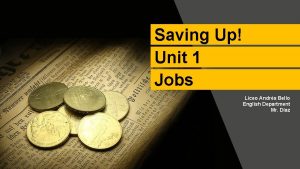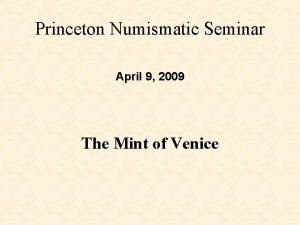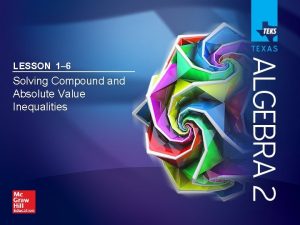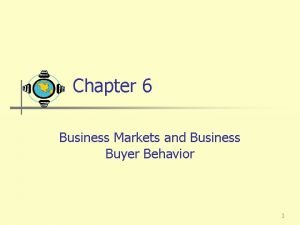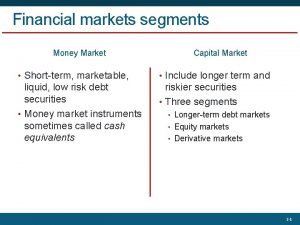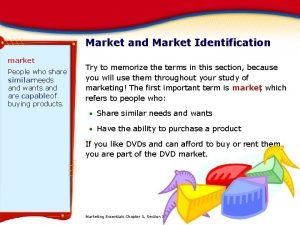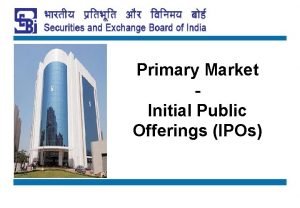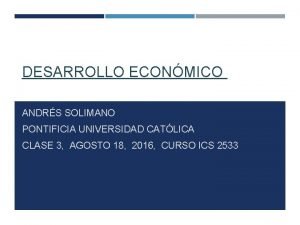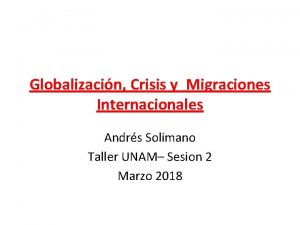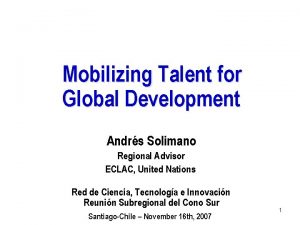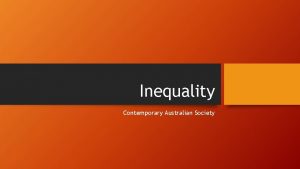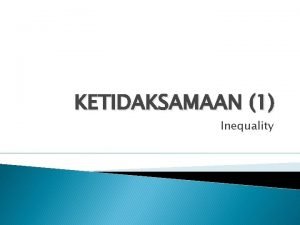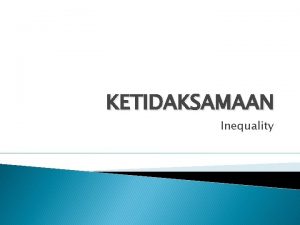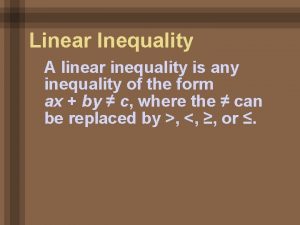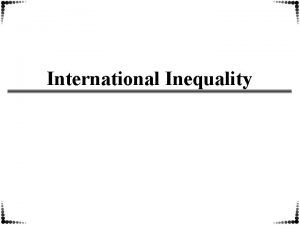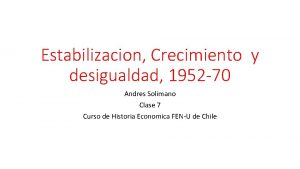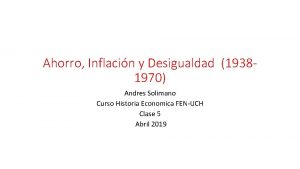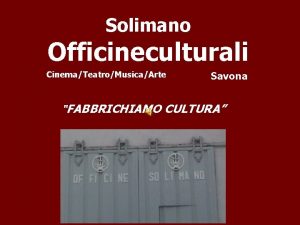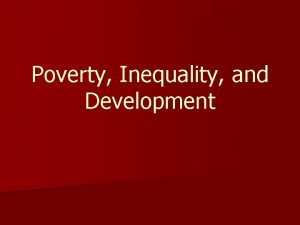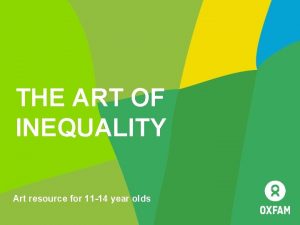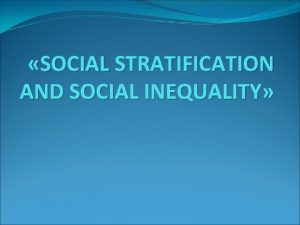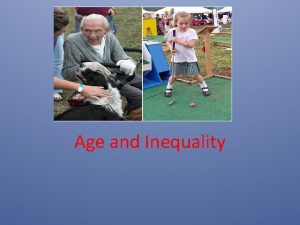Inequality and the Art Market Andrs Solimano International



























- Slides: 27

Inequality and the Art Market Andrés Solimano International Center for Globalization and Development (CIGLOB) Inequality and…? , lecture series, Luxembourg June – 2019.

Motivation • Art in times of high wealth creation (concentrated at the top), uncertainty, macro crises, trade-wars, de-globalization. • The strong irruption of the global art market (paintings, sculptures, prints, drawings, artifacts): annual sales of 67 billion dollars and rising (2018). . • Art as a refuge to financial and geopolitical turbulence? • Dual role of artwork: aesthetic enjoyment and investment asset. • Declining public support for the arts. • Influence of big money/wealth on the art market. • Extravagant prices (Koons, Da Vinci, Monet, Hockney). • Market- segmentation, big sales in large auction houses/large galleries but quantities in middle size-small galleries.

Monet’s Haystack (sold, USD 110 million).

Da Vinci ‘s “ Salvatore Mundi” (sold, USD 450 million)

Jeff Koons (living artist)’s “Rabbit” (sold, USD 91 million)

Motivation (cont. ) • Macroeconomic cycles and financial crises (e. g 2008 -09) and the art market. • Is art a “safe-heaven” asset? • Does art rise the value of portfolios in bad times ? • Wealth shocks and the demand for art. • Valuation conundrums.

Themes of the Presentation • A. Main Features of the Art Market. • B. Art Prices During Macroeconomic Cycles and Financial Crises. • Stocks and Gold. • Safe-havens. • Historical Evidence and Correlation Analysis. • C. Wealth Inequality and the Art Market.

A. Seven Features of the Art Market • Transaction costs and liquidity. • Privatization and Financialization. • Concentration and Polarization. • Sensitivity to macroeconomic cycles and crises. • Lack of regulation, tax avoidance/elusion, money laundering. • Increasingly globalized market: main players (USA, UK, China). • Niche market influenced by high wealth concentration at the top.

(i) Transaction costs and liquidity. • Art objects are unique and heterogeneous. • Cost of finding buyers. • Forgery and provenance issues. • Masterpieces have infrequent sales. • All this makes transactions costs non-trivial. • The ability of a collector or buyer to convert a piece of art into money can be limited. This is a market with potential lack of liquidity.

(ii) Privatization and Financialization • Growing private ownership of artwork of high-value. How affects public museums? . • The art market is increasingly financialized with art becoming a vehicle of investment — a new asset-class. • Hedge funds, family offices, art investment funds, commercial banks all interested in investing in art. Knowledge needs. • Average rate of return from trading in artworks does not differ, substantially, from the return of holding stocks or bonds once adjusted by risk premiums. The Keynes collection study.

(iii) Concentration and Polarization Share of Lots Sold and Total Value at Global Fine Art Auctions in 2017 by Price Bracket. Lower-end • The bulk of the number of transactions – volume- is concentrated at the lowerend of the market, while the bulk of sales value is concentrated at the higherend of the market. • The auction segment of the market, now accounts for almost half of the total fine art sales in 2017—$28. 5 billion of $63. 7 billion (Mc. Andrew, 2018, 16). • The upper-end of the art market is characterized by highly personal relations and rather obscure practices regarding price and fee Value Volume 8. 6% 89. 8% 27. 9% 9. 4% 63. 5% 0. 9% 100. 0% (Below $50 k) Middle Market ($50 k - $1 m) High-end (Above $1 m) Total Source: Mc. Andrew, C. (2018).

(iv) Sensitivity to macroeconomic cycles The Global Art Market: Value and Volume of Transactions, 20082018 • The aggregate evidence suggests the art market tends to behave in a pro-cyclical way, with total sales/volumes rising in the upswings, and declining in the downturns of the business cycle. • Upward and downward cycles can affect differently the various segments of the art market. Source: Table 1, Mc. Andrew (2019)

(v) Lack of Regulation, Tax Avoidance/ Tax Elusion, Money Laundering. • Weak regulation of the art market. • Little protection to buyers from manipulative practices. • Freeports: Top collectors are increasingly buying artwork as investments to reduce their tax burden. • Money-laundering through acquisition of art?

(vi) The art market is increasingly globalized Global Art Market Share by Value in 2018 • The US, UK and China concentrate over 80 percent of total sales in art followed by France, Germany and Switzerland. • In the 1970 s and 1980 s, the Asian regional art market started to rise. First, conducted by Japan and nowadays, by China. Source: Art Market 2019

(vii) The Art Market is Influenced by Wealth Inequality Number and Wealth of Dollar Millionaires 2010– 2018 • The evidence shows the growth of the art market and the predominance of its upper-end has coincided with the rapid increase in the number of wealthy people and the growth in their assets in the world economy Source: Art Market 2019

B. Art Prices, Stocks and Gold in Macro Cycles and Financial Crises (1998 -2018, quarterly)

Art Prices in the 1998 -2018 cycle. Pre crisis increase (T/P) Change, % (1998 Q 1 -2008 Q 1) 64. 6 Crisis correction (P/T) (2008 Q 1 - 2009 Q 4) -39. 6 Recovery/Boom (T/P) (2009 Q 4 - 2011 Q 3) 77. 0 New correction (P/T) (2011 Q 3 -2018 Q 4) -53. 0 ———————— Note: T= Trough, P=Peak. Elaboration from series from Artprice. com in real dollars of 2015 Q 4, deflated by US CPI.

Stock Prices (S&P 500) in the 1998 -2019 Cycle. Pre-crisis increase (T/P) Change, % 1998(Q 1)- -2007(Q 3) 14. 2 Crisis correction (P/T) 2007(Q 3)- 2009(Q 1) -47. 0 Post-crisis recovery/boom (T/P) 2009(Q 1) – 2018(Q 3) 197. 0

Gold Prices in Three Crisis: Great Depression (1930 s), Stagflation (1970 s) and Global Financial Crisis (2008 -09). Real Price (USD per ounce) 1920 (6) 1929 (9) 1929 (12) 1934 (2) 1970 (12) 1980 (1) 2001 (3) 2005 (8) 2008 (3) 2011 (8) 2014 (11) Ratio peak/trough and percent change Great Depression of the 1930 s 235. 15 281. 23 282. 87 617. 93 Stagflation of the 1970 s 215. 7 2, 046. 0 Global Financial Crisis of 2008 -09 350. 5 523. 58 1, 064. 96 1, 891. 60 1, 176. 04 1. 19 (19%) 2. 18 (118%) 9. 48 (848%) 5. 39 (440%)

A Century of the Ratio of Gold Prices to Stock Prices, 1914 -2015.

Is Art a Safe-Haven Asset? • A safe haven asset/investment is one that its price (or rate of return) is either uncorrelated or negatively correlated with other assets of a portfolio. • Historical evidence of cycles shows that: • Art prices (aggregate indices) are pro-cyclical. • Stock prices are pro-cyclical. • Gold prices are counter-cyclical, a safe-haven asset. • Correlation analysis.

Price correlations Correlation Matrix between Art Prices, Financial Assets and Commodities (real prices, first quarter of 1998 to second quarter of 2018) Nikkei 225 • The evidence is not entirely conclusive for all indices but we can detect a negative correlation (significant at 99%) between the real global art price index and two stock market indices: the real Nikkei 225 and the real S&P 500. • At the same time the global art market price index (in USD) has a positive correlation with gold prices. S&P 500 Gold Oil Art Price Global Index (USD) Art Price Global Index (EUR) FTSE China A 50 A MSCI World Historical Data A Bitcoin B 1 S&P 500 0. 71 *** 1 Gold -0. 44 *** 0. 1 1 Oil -0. 5 *** -0. 19 * 0. 74 *** 1 Art Price Global Index (USD) -0. 33 *** -0. 37 *** 0. 29 *** 0. 7 *** 1 Art Price Global Index (EUR) -0. 01 -0. 15 -0. 24 ** 0. 1 0. 54 *** 1 FTSE China A 50 A 0. 14 -0. 04 0. 21 0. 19 1 MSCI World Historical Data A 0. 88 *** 0. 91 *** -0. 14 -0. 24 * 0. 09 0. 1 1 Bitcoin B 0. 59 *** 0. 68 *** -0. 33 * -0. 11 -0. 51 *** -0. 54 *** 0. 69 *** 1 Significance (99%)*** p<0. 01, signficance (95%) ** p<0. 05, * significance 90%( p<0. 1). A : Correlation are calculated from 2004 Q 4 B : Correlations are calculated from 2010 Q 3

C. Wealth Inequality and the Art Market • Wealth distribution within countries. • Wealth distribution between countries. • Wealth shocks and the art market.

Wealth Share of the top 1 percent in Five Main Economies.

Number and Wealth of Millionaires, 20102018

Global Share of Millionaires with Wealth in Excess of $50 Million in 2018 (USA and China dominate, they are also the main art markets)

Art and Wealth Shocks • Recession-led decline in asset prices and wealth reduces the demand for artworks. • Are Masterpieces resilient to adverse wealth shocks? • Are artworks a “safe-haven”? • Wealth concentration at the top and market segmentation (niche market for artwork of high value). • Positive correlation between the number and stock of wealth of millionaires and billionaires and the price of artwork
 Andrs bello
Andrs bello Andrs mint
Andrs mint Lesson 1-6 compound inequalities
Lesson 1-6 compound inequalities Market segmentation lesson
Market segmentation lesson Leader challenger follower
Leader challenger follower Primary target market and secondary target market
Primary target market and secondary target market 6 markets model
6 markets model Money market segments
Money market segments Market and market identification
Market and market identification What is ipo
What is ipo Unorganised money market
Unorganised money market Hát kết hợp bộ gõ cơ thể
Hát kết hợp bộ gõ cơ thể Ng-html
Ng-html Bổ thể
Bổ thể Tỉ lệ cơ thể trẻ em
Tỉ lệ cơ thể trẻ em Gấu đi như thế nào
Gấu đi như thế nào Chụp tư thế worms-breton
Chụp tư thế worms-breton Alleluia hat len nguoi oi
Alleluia hat len nguoi oi Môn thể thao bắt đầu bằng từ chạy
Môn thể thao bắt đầu bằng từ chạy Thế nào là hệ số cao nhất
Thế nào là hệ số cao nhất Các châu lục và đại dương trên thế giới
Các châu lục và đại dương trên thế giới Cong thức tính động năng
Cong thức tính động năng Trời xanh đây là của chúng ta thể thơ
Trời xanh đây là của chúng ta thể thơ Mật thư tọa độ 5x5
Mật thư tọa độ 5x5 Làm thế nào để 102-1=99
Làm thế nào để 102-1=99 Phản ứng thế ankan
Phản ứng thế ankan Các châu lục và đại dương trên thế giới
Các châu lục và đại dương trên thế giới Thơ thất ngôn tứ tuyệt đường luật
Thơ thất ngôn tứ tuyệt đường luật
